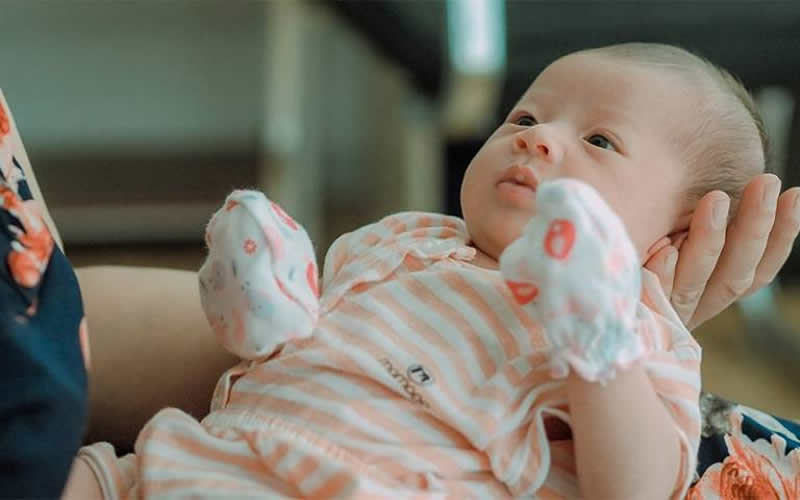Summary: Contractions of the diaphragm muscles during hiccuping evoke a significant response in the brain’s cortex, causing two large brainwaves followed by a third. The third brainwave is similar to that evoked by noise.
Source: UCL
Each time a newborn baby hiccups, it triggers a large wave of brain signals which could help the baby learn how to regulate their breathing, finds a new UCL-led study.
The study, published in Clinical Neurophysiology, was based on brain scans of newborn infants.
“The reasons for why we hiccup are not entirely clear, but there may be a developmental reason, given that foetuses and newborn babies hiccup so frequently,” said the study’s lead author, research associate Kimberley Whitehead (UCL Neuroscience, Physiology & Pharmacology).
Pre-term infants are particularly prone to hiccups, as they spend an estimated 1% of their time hiccupping – roughly 15 minutes a day. Hiccups begin in the womb at just nine weeks gestational age, making them one of the earliest established patterns of activity.
The present study involved 13 newborn infants in a neonatal ward who had a bout of hiccups. The babies were pre-term and full-term, ranging from 30 to 42 weeks gestational age (equivalent), so their development could reflect what’s typical in the last trimester of pregnancy.
Brain activity was recorded with EEG (electroencephalography) electrodes placed on the scalp, while movement sensors on the infants’ torsos provided a linked record of when they were hiccupping.
The same researchers have previously suggested that babies kicking in the womb may be creating mental maps of their own bodies,* and say their new findings may reflect the same process for the internal body.

The researchers found that contractions of the diaphragm muscle from a hiccup evoked a pronounced response in the brain’s cortex – two large brainwaves followed by a third. As the third brainwave is similar to that evoked by a noise, a newborn baby’s brain may be able to link the ‘hic’ sound of the hiccup with the feel of the diaphragm muscle contraction. The researchers say that postnatal processing of multi-sensory inputs is important to develop brain connections.
“The activity resulting from a hiccup may be helping the baby’s brain to learn how to monitor the breathing muscles so that eventually breathing can be voluntary controlled by moving the diaphragm up and down,” said the study’s senior author, Dr Lorenzo Fabrizi (UCL Neuroscience, Physiology & Pharmacology).
“When we are born, the circuits which process body sensations are not fully developed, so the establishment of such networks is a crucial developmental milestone for newborns,” he continued.
Kimberley Whitehead said: “Our findings have prompted us to wonder whether hiccups in adults, which appear to be mainly a nuisance, may in fact by a vestigial reflex, left over from infancy when it had an important function.”
Funding: The research was carried out at UCL Neuroscience, Physiology & Pharmacology and the Elizabeth Garrett Anderson Maternity Wing at University College London Hospitals NHS Foundation Trust (UCLH), and funded by the Medical Research Council, with support from the National Institute for Health Research UCLH Biomedical Research Centre.
Source:
UCL
Media Contacts:
Chris Lane – UCL
Image Source:
The image is adapted from the UCL news release.
Original Research: Open access
“Event-related potentials following contraction of respiratory muscles in pre-term and full-term infants”. Kimberley Whitehead.
Clinical Neurophysiology doi:10.1016/j.clinph.2019.09.008.
Abstract
Event-related potentials following contraction of respiratory muscles in pre-term and full-term infants
Objective
Involuntary isolated body movements are prominent in pre-term and full-term infants. Proprioceptive and tactile afferent feedback following limb muscle contractions is associated with somatotopic EEG responses. Involuntary contractions of respiratory muscles, primarily the diaphragm – hiccups – are also frequent throughout the human perinatal period during active behavioural states. Here we tested whether diaphragm contraction provides afferent input to the developing brain, as following limb muscle contraction.
Methods
In 13 infants on the neonatal ward (30–42 weeks corrected gestational age), we analysed EEG activity (18-electrode recordings in six subjects; 17-electrode recordings in five subjects; 16-electrode recordings in two subjects), time-locked to diaphragm contractions (n = 1316) recorded with a movement transducer affixed to the trunk.
Results
All bouts of hiccups occurred during wakefulness or active sleep. Each diaphragm contraction evoked two initial event-related potentials with negativity predominantly across the central region, and a third event-related potential with positivity maximal across the central region.
Conclusions
Involuntary contraction of the diaphragm can be encoded by the brain from as early as ten weeks prior to the average time of birth.
Significance
Hiccups – frequently observed in neonates – can provide afferent input to developing sensory cortices in pre-term and full-term infants.






